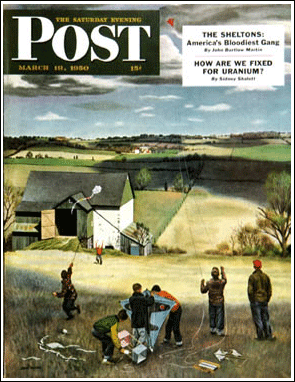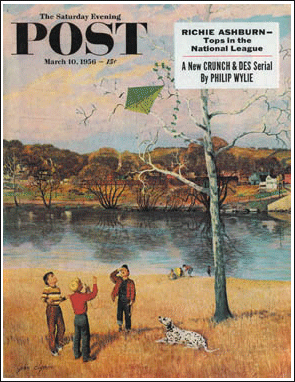Kites on Magazine Covers - The Saturday Evening Post
Prior to the advent of the Internet, popular magazines were a major communications format. They were widely distributed through news stands and personal subscriptions. Popular magazines generally catered to current or seasonal interests of the general population. Some were targeted to specific interest or age groups and contained articles related to a theme.
 These magazines usually used the cover display space to grab the potential reader's interest and prompt a purchase for reading on one's own time. The largest popular magazines targeted at the general population in the 1900's often featured "cover art" before photography took over and dominated the frontispiece. Some magazines made it a hallmark to use the work of noted artists who conveyed an essence of the times and captured reader interest. Noteworthy among this type of magazine was the famed Saturday Evening Post published by the Hearst Corporation.
These magazines usually used the cover display space to grab the potential reader's interest and prompt a purchase for reading on one's own time. The largest popular magazines targeted at the general population in the 1900's often featured "cover art" before photography took over and dominated the frontispiece. Some magazines made it a hallmark to use the work of noted artists who conveyed an essence of the times and captured reader interest. Noteworthy among this type of magazine was the famed Saturday Evening Post published by the Hearst Corporation.
Over the years my fascination with kite history has prompted me to collect both books and 'old paper' (magazines, journals, print advertising etc.) There are many examples of kite art on the covers of old magazines that are of interest to serious kite hobbyists.
The Saturday Evening Post published two covers devoted to kite art in the 1950's. Both are outstanding examples of the type of art that captures a time and a mood. Both evoked images of childhood and nostalgic feelings in buyers of the magazines.
The Post's two kite art covers were painted by famed American artist John Falter (1910-1982). In all Falter published 128 covers for the Saturday Evening Post. His first cover art, a rendition of Benjamin Franklin, was published in 1943. This led to a twenty-five year association with the Post until it ceased publication in 1969.
 The first kite art by John Falter published on the cover of the Saturday Evening Post was the March 18, 1950 edition of the magazine. It was based on a painting entitled "Bucks County Spring". The cover captures the farmlands of Bucks County situated in the Delaware Valley, not far from Philadelphia, Pennsylvania. In the foreground are a group of boys, likely in the twelve to fifteen year age range, who are either readying kites for flight or flying them. This is likely one of the most sought after magazine covers by kite ephemera collectors. My copy of this Post cover is a prized possession in my collection.
The first kite art by John Falter published on the cover of the Saturday Evening Post was the March 18, 1950 edition of the magazine. It was based on a painting entitled "Bucks County Spring". The cover captures the farmlands of Bucks County situated in the Delaware Valley, not far from Philadelphia, Pennsylvania. In the foreground are a group of boys, likely in the twelve to fifteen year age range, who are either readying kites for flight or flying them. This is likely one of the most sought after magazine covers by kite ephemera collectors. My copy of this Post cover is a prized possession in my collection.
The simple beauty and emotions evoked by this painting capture the best of what every adult remembers about kite flying in their youth. For adult kite enthusiasts, the feelings tap into what we still feel every time we ready or launch a kite into the crisp Spring sky.
What is so unique about this photo is the array of kites of historical interest that are shown. Falter depicts one of the most famous kites of all time, the Garber Target Kite, being readied for flight by two boys in the lower foreground of the painting. The Garber kite is the traditional sky blue sail color with the outline of a Japanese Zero airplane on the kite sail.
The other kites depicted (bottom to top) are: -a skyscraper box kite; -a white sailed hexagonal three stick kite (flying above the barn roof); and -a red sailed version of a diamond kite (very top of photo by the Post logo). The red diamond kite is being flown with two lines and is thus a very maneuverable kite, much like the Garber Target Kite shown in the image.
To prepare for his painting, John Falter actually purchases some Garber Target Kites from a surplus store and built a large box kite with a friend as well. He spent time flying the kites and then put all his experience into the painting using young boys as his subjects for the experiences he had gained first hand. Likely this is why there is such realism in the painting.
On the inside of the Saturday Evening Post, a brief note about the cover painting provides these insights:
"This cover landed John Falter in his second childhood. A man can't paint kites unless he flies a few, can he? Falter bought some Navy target-gunnery jobs - double-string rudder-control affairs like the red and blue ones in the picture - and Mrs. Falter became a kite widow. Then Falter and friend Arthur Naul built an eight-foot box contraption. The leviathan flew too. Until eventually it crashed, and now it will never fly again. As time went on, people got to inquiring whether those old guys always out there playing with the kites were balmy or what. Finally, when the Post phoned Falter and asked him where under the sun his kite painting was, he sadly wrenched himself back into his vale of labor, and started painting, fast."
Using the date of the Post cover some historical analysis can be performed. We know that by 1950 the Garber Target Kites, mainly manufactured by the Spaulding Company for use as targets for naval gunnery crews, were widely available in Army surplus stores for a few dollars. Today, a well preserved specimen is valued well above $200.oo (US currency). So, it appears the boys have picked up a great kite treasure to enjoy the Spring afternoon.
The 'skyscraper' box kite was popular in the 1940's and '50's as well. Unlike a Hargrave's box kite which had elongated boxes at top and bottom, the skyscraper box kite utilized totally square box cells at top and bottom. These were usually spaced apart by an open section in the frame equal to one and one half times the size of the square box cell.
The three stick hexagonal kite was a favourite of all young kite makers. Dating back to the mid-1800's, the hexagonal kite's simplicity of framing, overlapping three sticks and attaching them to the six corners of the kite sail, made this kite one of the easiest to build. Since this kite is essentially a 'flat kite', it required a tail to control sideways yaw and prevent a spinning crash to the ground. Getting the length and weight of the tail just right for the wind conditions was often a frustrating process for impatient young fliers.
 On March 10, 1956 the Saturday Evening Post once again decided to herald the arrival of Spring with another John Falter kite art piece. This one shows a group of three young boys in the foreground with their trusty Dalmatian dog, looking up at a tree which has captured the green diamond kite. This kite is clearly an Eddy diamond variant since it is much taller than it is wide. This shape made it essential to attach a tail for flight stability. The tail is nicely wrapped in the tree branches as well, making one speculate that the day's kite flying adventure is over and a new kite has to be made.
On March 10, 1956 the Saturday Evening Post once again decided to herald the arrival of Spring with another John Falter kite art piece. This one shows a group of three young boys in the foreground with their trusty Dalmatian dog, looking up at a tree which has captured the green diamond kite. This kite is clearly an Eddy diamond variant since it is much taller than it is wide. This shape made it essential to attach a tail for flight stability. The tail is nicely wrapped in the tree branches as well, making one speculate that the day's kite flying adventure is over and a new kite has to be made.
Kiters know this feeling very well. A favorite kite caught in a tree can pretty much put a damper on a nice afternoon of flying. I can remember well the times I lost a kite as a youngster. One wonders whether Falter's painting was based on a scene he came upon while out sketching, or if the source of his art was a childhood memory of a tangled kite and the abrupt end to an afternoon of fun.
During his career John Falter produced more than 5000 paintings, several of which are in prominent museums displaying "Americana" art. Falter did produce one additional painting that shows three boys with a kite in a farmer's field. This painting resides in the collection at the Atchinson Art Association in Atchison, Kansas and was not published as a magazine cover piece.
Some of John Falter's Post covers are of a style that many people ascribe to the more famous Norman Rockwell (1894-1978), who also painted very memorable covers for the Saturday Evening Post. Falter's work is generally more realistic and slightly less "character-esque" than the iconic art of Rockwell. Both are credited with giving the Post distinguishable "All American" cover images that were a hallmark of the publication. Rockwell contributed 322 covers to the Saturday Evening Post.
I am still conducting research on the complete set of Saturday Evening Post covers. There is one painting by Norman Rockwell, entitled "Old Man and Boy: Flying the Kite", which may have made it to the cover of the Post. As yet, I have not been able to confirm this.





Reader Comments (1)
César Castillo